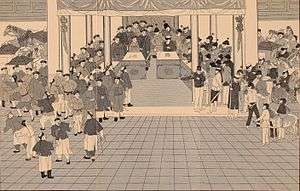Convention of Peking
The Convention or First Convention of Peking is an agreement comprising three distinct treaties concluded between the Qing dynasty of China and Great Britain, France, and Russian Empire in 1860. In China, they are regarded as among the unequal treaties. The Ministry of Foreign Affairs of the Republic of China keeps the original copy of the convention in the National Palace Museum in Taiwan.[1]
| Convention of Peking | |||||||||||||||
|---|---|---|---|---|---|---|---|---|---|---|---|---|---|---|---|
 Signing of the treaty by Lord Elgin and Prince Gong | |||||||||||||||
| Traditional Chinese | 北京條約 | ||||||||||||||
| Simplified Chinese | 北京条约 | ||||||||||||||
| |||||||||||||||
| This article is part of a series on the |
| History of Hong Kong |
|---|
 |
| Timeline |
| By topic |
|
Background
On 18 October 1860, at the culmination of the Second Opium War, the British and French troops entered the Forbidden City in Beijing. Following the decisive defeat of the Chinese, Prince Gong was compelled to sign two treaties on behalf of the Qing government with Lord Elgin and Baron Gros, who represented Britain and France respectively.[2] Although Russia had not been a belligerent, Prince Gong also signed a treaty with Nikolay Ignatyev.
The original plan was to burn down the Forbidden City as punishment for the mistreatment of Anglo-French prisoners by Qing officials. Because doing so would jeopardize the treaty signing, the plan shifted to burning the Old Summer Palace and Summer Palace instead.[2] The treaties with France and Britain were signed in the Ministry of Rites building immediately south of the Forbidden City on 24 October 1860.[3]
Terms

In the convention, the Xianfeng Emperor ratified the Treaty of Tientsin (1858).
The area known as Kowloon was originally leased in March 1860. The Convention of Peking ended the lease, and ceded the land formally to the British on 24 October 1860.[4]
Article 6 of the Convention between China and the United Kingdom stipulated that China was to cede the part of Kowloon Peninsula south of present-day Boundary Street, Kowloon, and Hong Kong (including Stonecutters Island) in perpetuity to Britain.
Article 6 of the Convention between China and France stipulated that "the religious and charitable establishments which were confiscated from Christians during the persecutions of which they were victims shall be returned to their owners through the French Minister in China".[5]
The treaty also ceded parts of Outer Manchuria to the Russian Empire. It granted Russia the right to the Ussuri krai, a part of the modern day Primorye, the territory that corresponded with the ancient Manchu province of East Tartary. See Treaty of Aigun (1858), Treaty of Nerchinsk (1689) and Sino-Russian border conflicts.
Aftermath
The governments of the United Kingdom and the People's Republic of China (PRC) concluded the Sino-British Joint Declaration on the Question of Hong Kong in 1984, under which the sovereignty of the leased territories, together with Hong Kong Island, ceded under the Treaty of Nanjing (1842), and Kowloon Peninsula (south of Boundary Street), was transferred to the PRC on 1 July 1997.
References
- http://www.npm.gov.tw/exh100/diplomatic/page_en02.html Republic of China's Diplomatic Archives (English)
- Harris, David. Van Slyke, Lyman P. [2000] (2000). Of Battle and Beauty: Felice Beato's Photographs of China. University of California Press. ISBN 0-89951-100-7
- Naquin, Susan. [2000] (2000). Peking: Temples and City Life, 1400-1900. University of California Press. ISBN 0-520-21991-0
- Endacott, G. B.; Carroll, John M. (2005) [1962]. A biographical sketch-book of early Hong Kong. Hong Kong University Press. ISBN 978-962-209-742-1.
- Herbermann, Charles, ed. (1913). . Catholic Encyclopedia. New York: Robert Appleton Company.
Further reading
- Cole, Herbert M. "Origins of the French Protectorate over Catholic Missions in China." American Journal of International Law 34.3 (1940): 473–491.
External links
| Russian Wikisource has original text related to this article: |